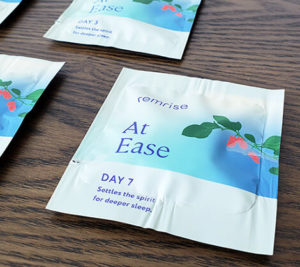
When I started my week-long test of Remrise, my first thoughts were that the concept of non-prescription sleep aids has undergone a beauty treatment.
The attractive and interactive website. The shiny iridescent box with the seven daily packs. The pretty leaflet explaining the East meets West ingredients. Natural ingredients converted into a fluffy pink powder in capsules.
Remrise is nothing like the generic plastic bottles of anti-histamines or melatonin we’re used to picking up from the pharmacy.
I admit I wondered if it was right for a sleep aid to look this attractive. So for me personally, it was going to be important that it works well.
If it does work, and without any suspect ingredients or side effects, then I’d probably forgive the unusually glossy image.
So I set out to test it for a week to find out if the effects lived up to expectations. I decided to use a sleep tracker to see if my thoughts on how I slept were also reflected in the App. It’s not an exact science, but I’ll still be sharing the data later in the article.
For now, let’s start at the beginning with the quiz on their website to determine which formula is right for you.
My experience taking Remrise
The quiz and the formula
Remrise isn’t a one-size-fits-all sleep aid. Instead, they say they’ve created a personalised, tailored approach to sleep aids. And so they offer several different formulas, with a quiz on their website to work out which one is right for you.
As well as standard points like my age and gender, it asked me about my sleep and stress levels. Do I have trouble falling asleep or staying asleep? Do I have bad dreams? Do I struggle with an overactive mind at night?
19 questions and two minutes later, and I’m told ‘At Ease’ is the one for me. My sleep profile is apparently ‘under pressure’. Evidently my mind and spirit need soothing. That might sound a little esoteric, but since I do regular yoga and meditate to help me relax and stop overthinking, it kind of made sense.
Equally, perhaps many people in the modern day and age would relate to being told they are under pressure and need some soothing!
What’s in the box?
I don’t mean to harp on about the image and packaging, but it’s kind of hard to ignore.
Right from the moment my Remrise arrived, the attention to image was obvious. But personally, I’d prefer a plain box that doesn’t advertise the fact that I get mail order sleep aids.
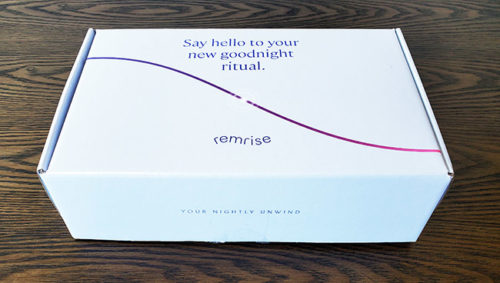
Inside the box, there’s an information leaflet and a smaller box. The leaflet looks like the work of a graphic designer, and is much nicer than standard patient information leaflets.
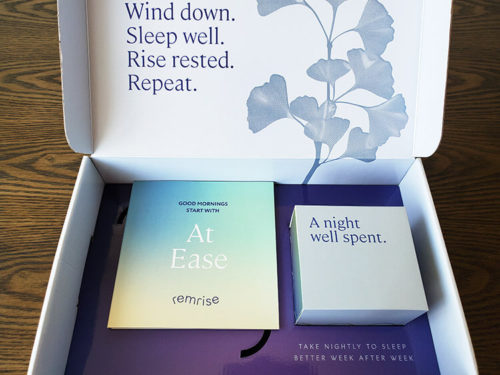
Inside the smaller box are seven packs. And inside each pack are four capsules. Finally, inside each capsule is a powdered blend of ingredients. It’s the Russian doll of sleep aids!
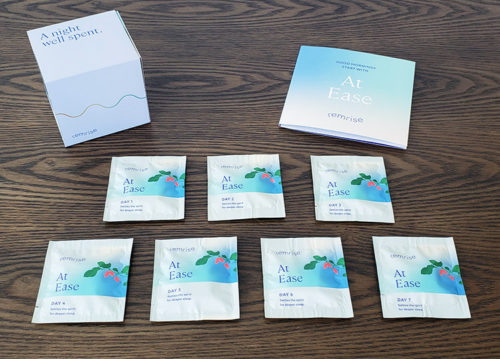
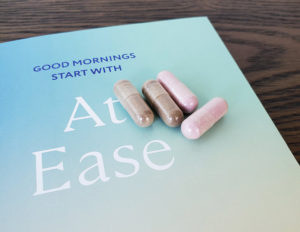
The ingredients
One of the reasons Remrise comes in daily packs is that they rotate some of the ingredients. This is apparently to stop you from building a tolerance to them. Other ingredients appear every day though.
Rather than list each different daily mix, here’s the entire range of ingredients that appear during the week:
- Salvia root (Dan Shen)
- Magnolia Bark (Hou Po)
- Reishi (Ling Zhi)
- Spine Date Seed (Suan Zao Ren)
- Schisandra (Wu Wei Zi)
- Polygala (Yuan Zhi)
- Spirit Poria (Fu Shen)
- Ginseng (Ren Shen)
- GABA
- 5HTP
- Tart Cherry
- Phosphatidylserine
- Magnesium Glycinate
- Calcium Citrate
- Valerian Root
- L-Tryptophan
- Hops Flower
- L-Theanine
- Passionflower
- Dragon Eye Fruit (Long Yan Rou)
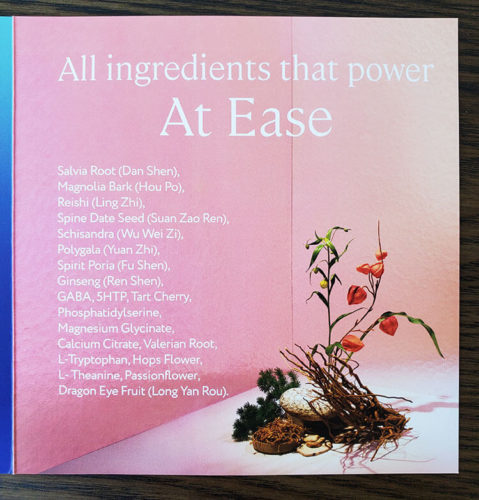
That’s a whopping 20 different ingredients! I’ve covered other sleep aids on my blog with multiple ingredients, but this one is in league of its own in terms of quantity.
Some of these are from Chinese medicine, while others are more commonly used in the west. The founder of Remrise, Veronica Lee, says she experimented with different ingredients to improve her own sleep and then worked with different practitioners to create the blends.
I’m not going to analyze every ingredient in this article, but I’ve looked them up and they all have some connection to sleep or relaxation. How strong the evidence is that they work, I’ll leave to you to research and make your own mind up about. Personally, I’m on the ‘inconclusive but I can see potential’ side of the fence.
Instructions and dosage
The leaflet advises three steps:
- One hour before bed, take your daily dose. This is four capsules inside the pack labelled ‘day 1’.
- 30 minutes before bed turn off screens and relax.
- Five minutes before sleep, make your room cool and dark, take five breaths and relax your body.
I like the fact that it gives you a gentle reminder to engage in some positive sleep hygiene.
What I didn’t like, however, was the size of the capsules. As you can see in the photo below, they are approximately 2 cm long and pretty chunky too.
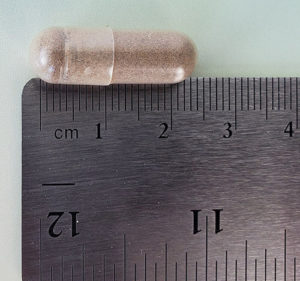
This is the first time I can remember where I could only take one capsule at a time, with a good amount of water to wash then down. At least there was no taste, and once washed down, I didn’t have any noticeable bad reaction to the four mini-submarines navigating my insides.
Night one
I woke up feeling pretty good after night one, and my Fitbit App showed I had seven hours’ sleep. For me, seven hours or more is a good night. The amount of REM and deep sleep looked normal. But as I’ll explain later, home sleep trackers can’t be completely trusted for sleep stage tracking.
So really, the main thing is how I felt. And I have to say I woke up feeling relatively refeshed and with no grogginess.
So far so good then.
Night two
Night two was almost an exact repeat of night one, again getting a solid seven hours. No grogginess or other side effects.
Night three
Night three was a bad night. I got a little under five hours’ sleep and felt pretty tired the next day. It’s not unheard of for me to sleep that badly, and does happen once in a while.
Nights four to seven
It seems that night three was a blip, as I slept well for the rest of the week. And on night six, I got an almost interrupted eight hours, which is rare for me.
My thoughts on Remrise so far
One bad night and six good nights. No side effects. Felt good most of the week. That pretty much sums it up.
Having no grogginess is particularly good for a sleep aid. With many I’ve tried in the past, especially anti-histamines, the next day fuzzy head or dry mouth can be annoying. So this was a positive for me. I’ve seen a couple of other reviews from people who said they had some grogginess, but that wasn’t my experience.
Is having one bad night a good trade-off for six good ones? Maybe. But ideally, I’d prefer not to have any bad nights when I take a sleep aid. But it’s impossible to say what caused it, and if the cause was one that no sleep aid would have prevented.
That’s one reason I’d like to try Remrise for longer to see if there are many more of the good nights, or if one of the days has an ingredient that disrupts my sleep.
Those are my personal reflections on the week. Now let’s take a look at what my sleep tracker showed to see if it can shed some light on how much my sleep changed compared to the three previous weeks when I didn’t take any sleep aids.
My sleep tracker data when I took Remrise
I have to admit I got a little carried away analyzing my sleep tracker data for the week I took Remrise and comparing it with each of the three previous weeks.
I’ve tried to only focus on the most interesting points I discovered. But please be aware that I’m not a statistician, and I only used a consumer wearable – the Fitbit Versa 2.
When I write on this website, I try to think from the perspective of the average person who owns a sleep tracker. So really, what follows is just me waking up each day and checking out my Fitbit App, as anybody might do. The only difference is that I put the numbers into some tables and thought about them more than I normally do.
So please treat the next few sections as someone taking a fairly casual look at their sleep tracker data – and in no way at all a rigorous scientific experiment.
Note that I took no sleep aids during the three weeks before the Remrise week. And since I’m writing this while on a COVID-19 pandemic stay at home order, I can guarantee that every week has been very, very similar to the one before in terms of daily activity and diet. Maybe I was more stressed in week four than week one though; it’s hard to say.
1. Total sleep time
To start with, I added each day’s total sleep for the week to get my total minutes for the week. I then divided it by seven to get an average in hours per night.
Table one below shows the results. The minus figure (in brackets) is how many fewer minutes I slept overall each week compared to the week I took Remrise.
Table 1
| Total week’s sleep (minutes) | Average per night (hours) | |
|---|---|---|
| Week 1 | 2864 (-27) | 6.49 |
| Week 2 | 2837 (-54) | 6.45 |
| Week 3 | 2795 (-96) | 6.39 |
| Remrise week | 2891 | 6.53 |
Compared to the week before (week 3), the improvement seemed pretty good in the Remrise week. 96 minutes more over the week – an average of 14 minutes of extra sleep each night.
There wasn’t one unusual night where I slept for a really long time. In fact, there was one really bad night, so the other six were all considerably better than the average of week three.
The gain was more modest compared to weeks one and two though. Just an average of four minutes per night during week one, and eight minutes on week two.
2. Sleep score
Sleep tracker overall ‘sleep scores’ need to be taken with a pinch of salt. Mainly because they take into account multiple factors, such as the total sleep time, time awake and restlessness, the time spent in light, REM, and deep sleep.
The problem is that they aren’t known to be totally accurate for sleep stages. However, it usually follows that when I feel I sleep well, it shows a high sleep score. And when I sleep poorly, the score is much lower. So it was still interesting to compare the average score for each week.
Table 2
| Average daily sleep score | |
|---|---|
| Week 1 | 76 |
| Week 2 | 79 |
| Week 3 | 77 |
| Remrise week | 79 |
The sleep score doesn’t seem to show much overall improvement with Remrise. Although it’s the highest with 79, week two is the same. Week one and three are lower scores, but not by much.
3. REM sleep, deep sleep and restless time
The similarity of the sleep scores was interesting and I was curious to understand why it wasn’t better. Did that one bad night totally skew the averages for the week?
I decided to dig deeper into some of the additional measurements the Fitbit App provides: the percentage time in the REM sleep stage, the total time in the deep sleep stage, and the percentage of time being restless.
Table 3
| Average time in REM (%) | Total deep sleep (mins) | Average restless (%) | |
|---|---|---|---|
| Week 1 | 19% | 84 | 9.9 |
| Week 2 | 20% | 80 | 10 |
| Week 3 | 21% | 91 | 9.7 |
| Remrise week | 20% | 87 | 10.1 |
The amount of time I’m restless doesn’t seem to change much from week to week, and actually seems marginally worse during the Remrise week. Perhaps one bad night’s sleep skewed this result as I was very restless that night.
The percentage of time I spend in REM sleep also doesn’t seem to vary much. The Remrise week was only better than one other week, and marginally so. Equally, it’s worse than week three and the same as week two. But those figures are all fairly normal sleep for an adult my age, so it’s not like I had a problem with REM sleep that Remrise fixed, or even needed to fix.
As for total deep sleep, it seems that week three is the winner. But at least the Remrise week is better than weeks one and two. Again though, they are all normal amounts for me, so I don’t think the figures show anything significantly interesting.
Thoughts on the sleep tracking data
I know I’m repeating myself, but I should mention once more the caveat that the sleep tracker data, especially for sleep stages, can’t be relied on completely. But I’ll still share my thoughts on what the data suggests.
For me, the only result that’s particularly interesting is the total sleep time. I know there are some differences in the deep sleep, restless and REM times, but they don’t strike me as being mind-blowing.
Perhaps if the previous weeks showed a clear lack of REM or deep sleep, and then it increased during the Remrise week, I would have had more to say. But all the measurements fall under the normal range, so I don’t feel like it’s worth focussing on – especially since it’s a relatively short test with just one consumer sleep tracker, and with one person!
But that potential increase in total sleep time is worthy of further exploration.
4. Remove the one bad night to see what happens
As I’ve mentioned, there was one particularly bad night’s sleep during the Remrise week. And in fact, it was the only night out of all 28 when I slept for less than five hours.
Out of curiosity, I calculated the average of just the other six nights to see what the figures would have looked like without that one bad night.
For simplicity’s sake, I’ve only included the total sleep and sleep score in the table below. If you’re interested, there was actually very little change in the other points.
Table 4
| Average per night (hours) | Sleep score | |
|---|---|---|
| Week 1 | 6.49 | 76 |
| Week 2 | 6.45 | 79 |
| Week 3 | 6.39 | 77 |
| Remrise 6 days | 7.13 | 81 |
Ahh, there’s nothing quite like fiddling the statistics! Now it seems like the Remrise week would have been the clear winner for total sleep and the overall sleep score.
I think if this had been the true outcome for all seven days (without my creative accounting), I would have been quite impressed. I don’t pay much attention to sleep scores when I look at my tracking data usually, but that increase in overall sleep time would have definitely gotten my attention.
It also perhaps helps explain why I felt pretty good most mornings the week I took Remrise (apart from the morning after that one terrible night). So I’m definitely interested in testing it for a longer period of time to see what happens if one night can’t skew the data so much.
Conclusion
As a reviewer, it’s frustrating when a product looks good, but there’s one point that makes it impossible for me to give a clear verdict. So despite seeing some potential, I think I need to take Remrise for a longer period of time.
In this case, it seems obvious to me that one bad night had a dramatic effect on the calculations I chose to do. When I removed that night, the average amount of sleep for the six good nights was much better than the average for the three weeks when I didn’t take Remrise.
A key question remains – did Remrise cause that bad night, or was it something else that even Ambien wouldn’t have suppressed?
Considering I had no side effects, and I felt refreshed and full of energy on six mornings out of seven, I’m happy to try it for a longer period of time. I’ve already ordered a month’s supply, and I’ll update this article once I finish it. Hopefully, I’ll have a clearer opinion of the overall effectiveness.
I like the idea of combining Eastern and Western ingredients. And although I think the packaging is a little over the top, it’s refreshing to see a new sleep aid that isn’t just another generic cloudy-head anti-histamine or yet another melatonin gummy.
Your views
Have you taken Remrise, or are thinking of taking it? Let me know your experience in the comments below, and if you have any thoughts about the ingredients.

I was amazed to see review that was exactly my experience. I have 6 out of 7 good nights. It has improved my life immensely. I recommend it all the time.
The best part, well second best thing is feeling good the next day. No side effects, just good old fashion sleep.
Helen T.
Hi Helen
Thanks for sharing your experience. It’s always useful to hear from readers who have tried a sleep aid I review.
Regards
Ethan